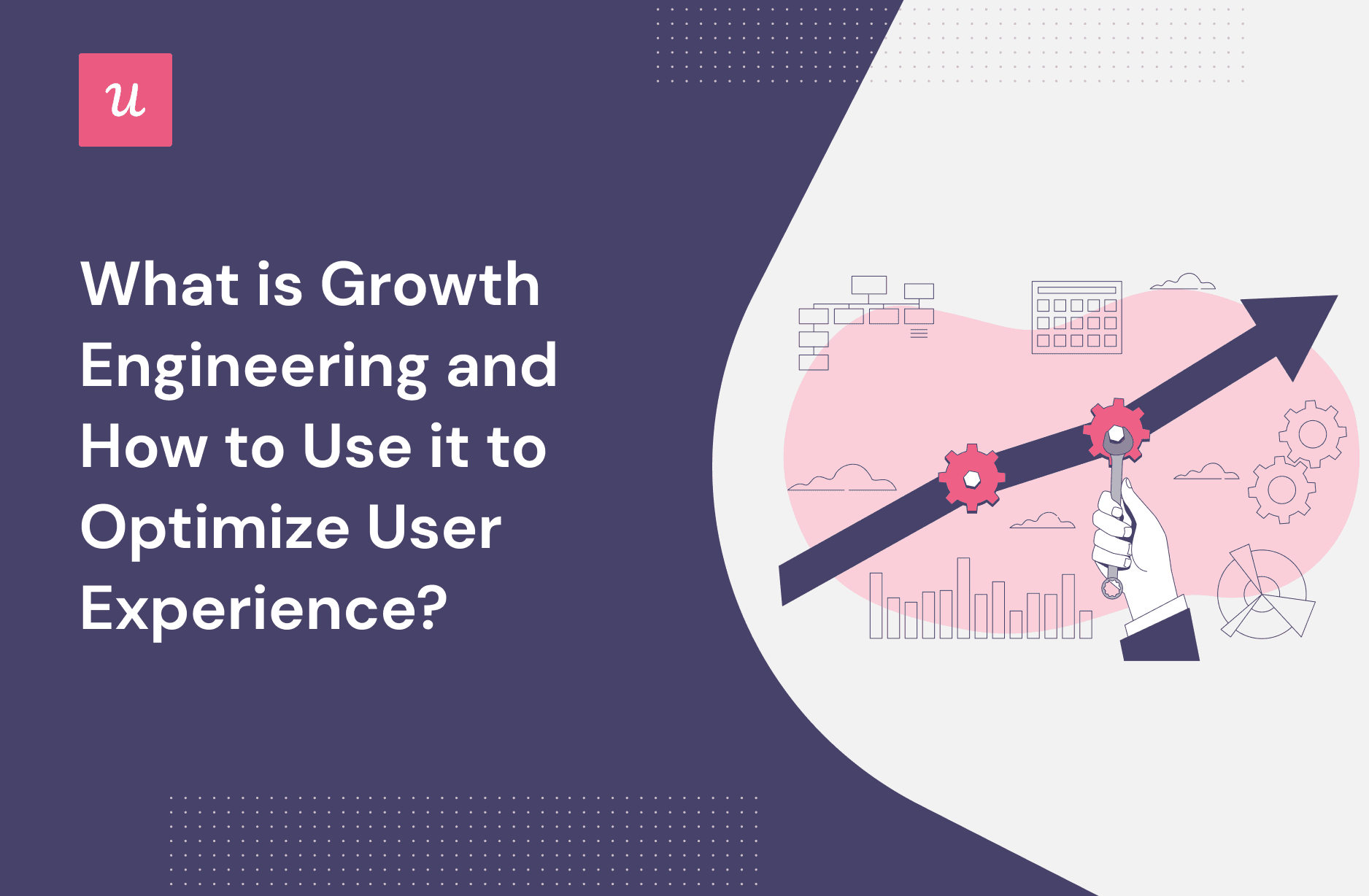
How can growth engineering help you take your marketing up a notch?
The SaaS market is saturated and continues to grow rapidly. Given that, you must take product growth seriously to ensure your continuous success. This is where growth engineering comes in handy.
In this article, we will be discussing everything you need to know about the growth engineering framework and its processes.
Let’s get started!
Try Userpilot Now
See Why 1,000+ Teams Choose Userpilot

What is growth engineering?
Growth engineering is a technical and systematic approach to organizational growth. It is a fusion of the scientific, data-driven decision-making method of software engineering and traditional marketing processes to produce custom growth solutions.
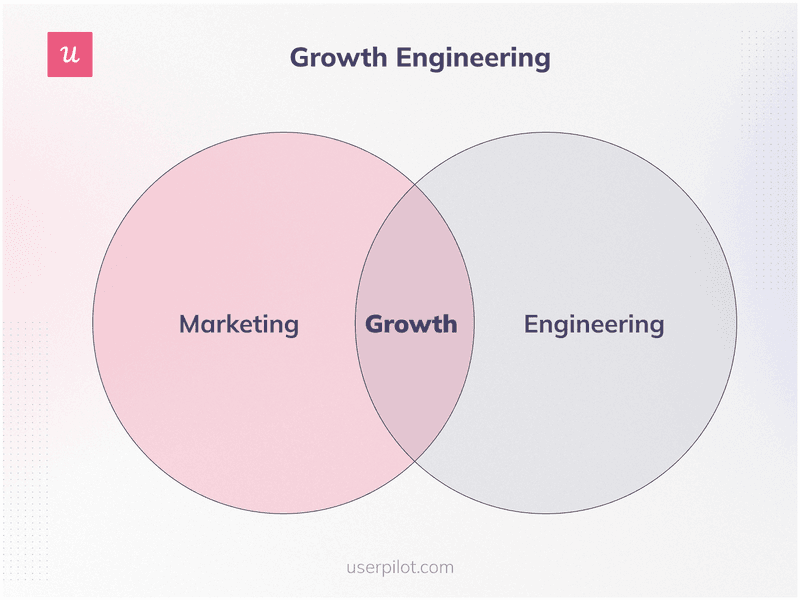
Why is growth engineering important for SaaS companies?
The success of growth engineering lies in its ability to break down siloes between interconnected teams. It unifies the engineering, product, and marketing teams into a single, cross-functional team working together for growth.
Unifying these three teams replaces the assumption-based decisions of traditional marketing teams with data-driven decisions. The only way to get this data is via experimentation.
As the growth team implements an experimental feature, they collect data on what works and doesn’t work. This data makes it easier to optimize product features and improve them to better the user experience.
Having a unified growth engineering team also encourages the free flow of information. As marketers identify desired new features or improvements using data-driven insights, they pass these along to the product engineering teams who work with them to innovate and improve the product.
Ultimately, growth engineering enables SaaS companies to iterate quickly, experiment with possible new solutions, and implement major or minor user experience improvements.
Growth hacking vs. growth engineering
Growth hacking refers to any marketing strategy focused solely on growth. The primary focus of a growth hacker is the use of creative, low-cost strategies for customer acquisition and retention.
Like growth engineers, growth hackers hypothesize, prioritize and test growth strategies while trying to identify a viable shortcut. Ambitious marketers employ growth hacking to drive rapid growth in a short time and on a small budget.
At their core, growth engineers share the same characteristics as growth hackers – they hypothesize and experiment with ideas. However, growth engineers go one step further, throwing data into the process and acting based on that data.
Growth engineering is, thus, a more methodological and systematic process with experimentation at its core. The growth engineer increases the product’s chances of success by making incremental changes to the core product.
What are the responsibilities of growth engineers in a growth team?
Iteration is the name of the game with the growth team. The growth engineer is constantly trying out new ideas, tracking the results with data, and using that data to boost conversions and customer experience.
A growth engineer’s responsibility includes everything from acquiring to retaining new customers and driving revenue growth. Thus, they constantly seek improvements in the user journey to keep it healthy. The growth engineer’s task may involve building internal tools to improve automated flows.
To achieve their goal of retaining customers, the growth engineer works to learn how customers use their products. They brainstorm on improvements to the product, optimize its features, and track the success of their optimizations on the customer experience using data.
Should growth engineers have technical skills?
Whether or not a growth engineer needs technical skills varies by company, product, and even their team.
The level of importance attached to the technical skills of a growth engineer often depends on the type of engineer required – a marketing background or a software engineering background.
Marketing Background: A marketer becomes a growth engineer (or growth hacker) by learning to code. The marketer may be adept at using tools like Zapier, Autopilot, and Unbounce to create automated flows or build websites.
Engineering Background: The software engineer boasts a technical degree and some business skills. They’re engineers with a wide range of skills, including frontend, backend, artificial intelligence, data pipelines, etc., who build complex engineering projects to solve business problems.
Regardless of the background, growth engineers look to solve business problems by combining their marketing and technical knowledge and experience.
Growth engineering framework for growth teams
Growth Engineering isn’t random. To determine what to experiment on and which experiments to implement, growth teams must possess in-depth knowledge of the customer and their behavior.
Enter the AARRR framework, which represents usage flows as funnels and is used to track current user behavior and improve the product experience.
Also known as the Pirate Metrics, this framework was designed by David McClure in 2005 as a system for grouping and tracking metrics at different user funnel stages – acquisition, activation, retention, referral, and revenue (AARRR).
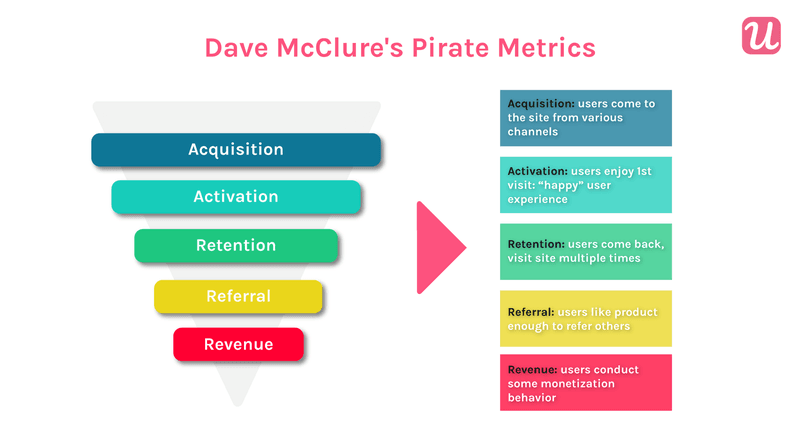
Acquisition
Customer acquisition aims at increasing the company’s customer base by increasing brand awareness. The goal of the growth team at this stage is to get new customers by making the product easier to find. You also want to simplify customer interactions as well as the signup flow.
Activation
Customer activation refers to everything you do to get the customer to engage with your product. Here, the growth team aims to help customers quickly derive value and reach their aha moment. Intuitive and interactive user onboarding is key to any successful user activation efforts.
Retention
Are your customers sticking around, or are they prone to churn? Carefully thought-out customer retention strategies turn customers into loyal supporters of your brand. Rendering continuous support to customers is one way to improve the customer experience and reduce churn.
Referral
Do your customers recommend your product to others? To ensure continued growth, growth teams work to improve customer loyalty, which, in turn, turns customers into loyal brand advocates. Ambitious growth teams harness happy customers to drive their word-of-mouth marketing strategy.
Revenue
Finally, growth teams implement customer expansion strategies to create more value for existing customers, increasing company revenue. Here, the growth team seeks out account expansion opportunities such as upselling and cross-selling to increase revenue without new customer acquisition.
Growth engineering process: How do growth engineers work?
The growth engineering process encompasses the tools and systems employed by growth engineers to identify opportunities, validate ideas, and drive growth. A successful growth process involves the following:
Track customers’ actions in-app and identify product usage patterns
The first part of a successful growth process is knowing the customer. Where is the customer from, and what do they hope to achieve with your product? How do they interact with your site? Once they’ve started using the product, you also need to learn what they do with it. But how can you do it?
Userpilot helps you to track what your customers are doing in-app and what features they use the most. Moreover, with feature tagging, you can see specific interactions such as clicks, hovers, and text inputs.
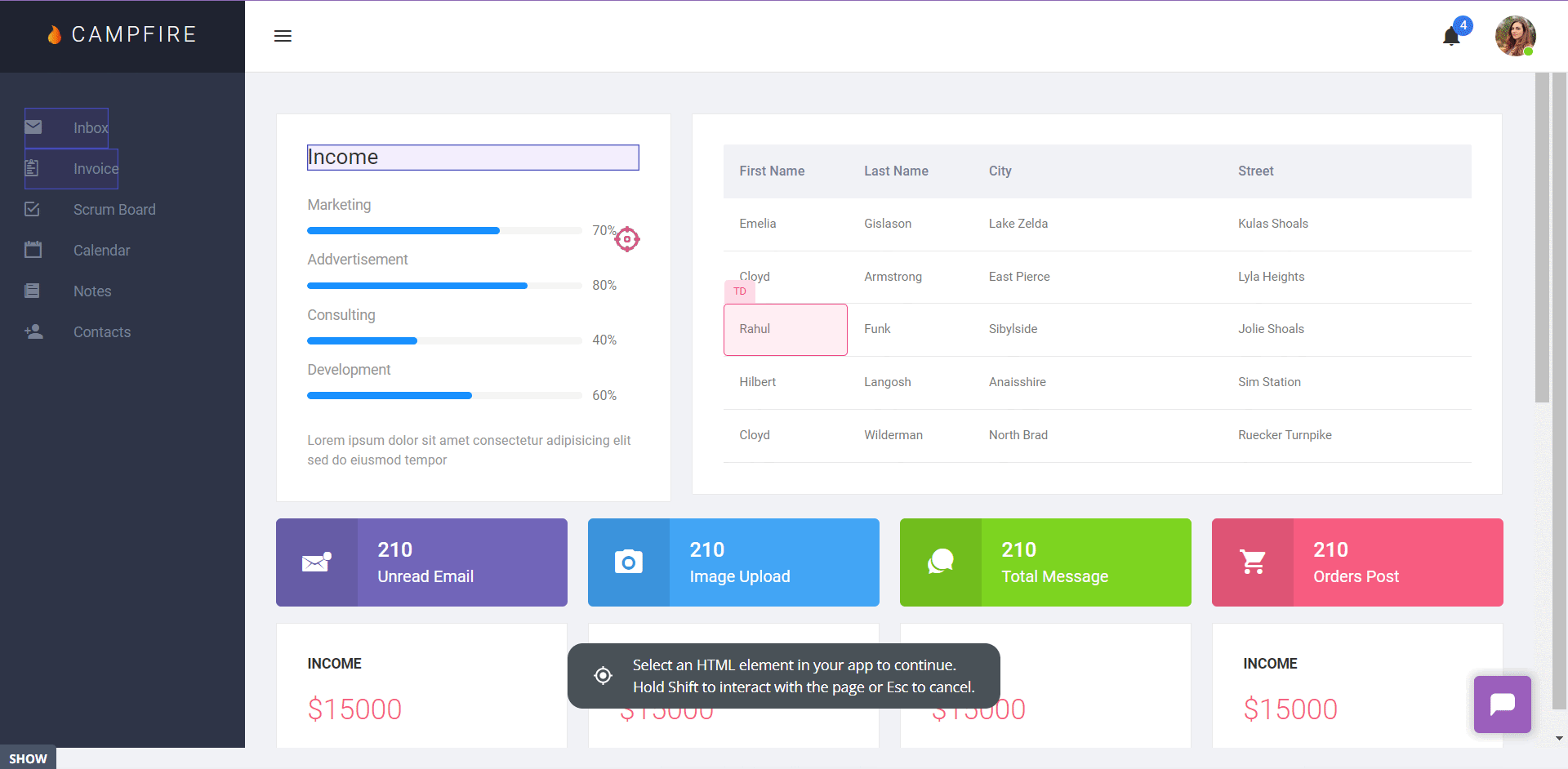
And with its new mobile capabilities, Userpilot now also helps you onboard and engage mobile app users by creating personalized messaging, push notifications, and surveys.
Then, you can segment users by feature usage and event occurrences to help you identify trends and patterns. This will help you better understand your customers and create personalized experiences for them.
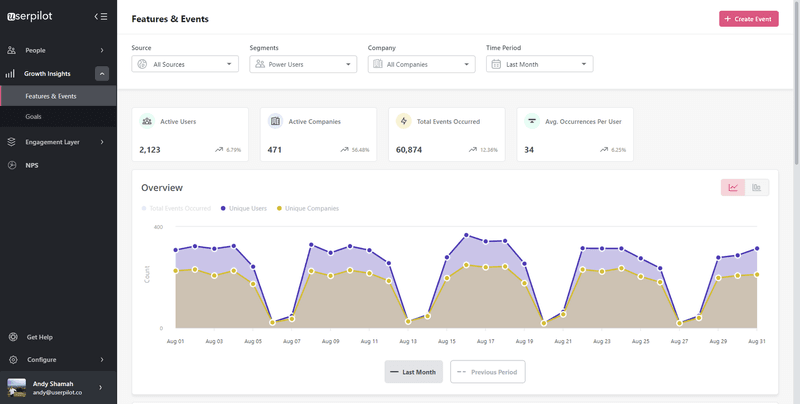
Use microsurveys to collect feedback on user experience
To understand what customers are thinking about your product, you should analyze the user experience from both quantitative and qualitative perspectives. The quantitative approach involves the use of objective metrics, whereas the qualitative approach relies on subjective feedback.
Microsurveys are a great way to collect invaluable insights about the user’s experience. Use different types of microsurveys, such as the NPS, CSAT, and CES, to collect user feedback at different user funnel stages.
Using the right product feedback tools you can collect, quantify, and analyze customer feedback to glean useful insights from them.
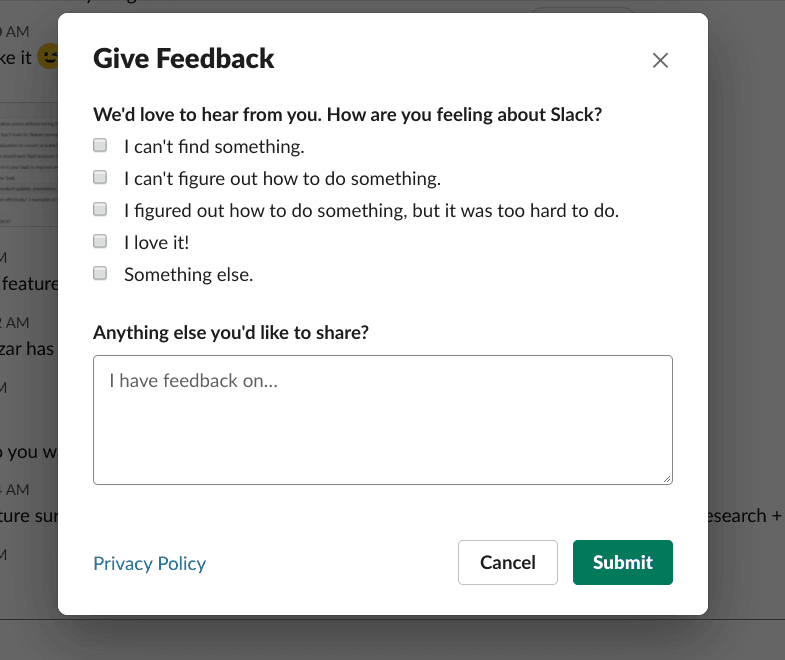
Generate data-driven experiment ideas
One of the most important facets of growth engineering is experimentation. Proper experimentation with the user interface (UI) emphasizes conversion and retention as the primary metric. This makes it easy to validate positive changes that improve the product experience.
To be successful, growth teams must iterate quickly, implementing hypotheses and experimenting with idea implementation. Implementing multiple ideas (and tracking relevant metrics) enables the team to compare the variations to identify the winning implementation.
Prioritize ideas and conduct A/B testing to user experience
How do growth teams determine the idea to work on? With the almost unlimited number of ideas the growth team can be working on, prioritization is a necessity.
Prioritize ideas based on engineering feasibility, design desirability, potential impact, and the strength of the hypothesis from an analytics perspective. Once an idea is selected, it’s time to experiment.
Build out any necessary backend or UI functionality based on the proposal. Then, launch and implement the change as part of an A/B testing experiment. This involves the use of a control group with no changes applied and a variation/test group with the changes applied.
A/B testing your ideas allows you to assess the results of the changes in real time. Experimental ideas should only be accepted if the test group (group B) performs better than the control group (group A) in the target metric.
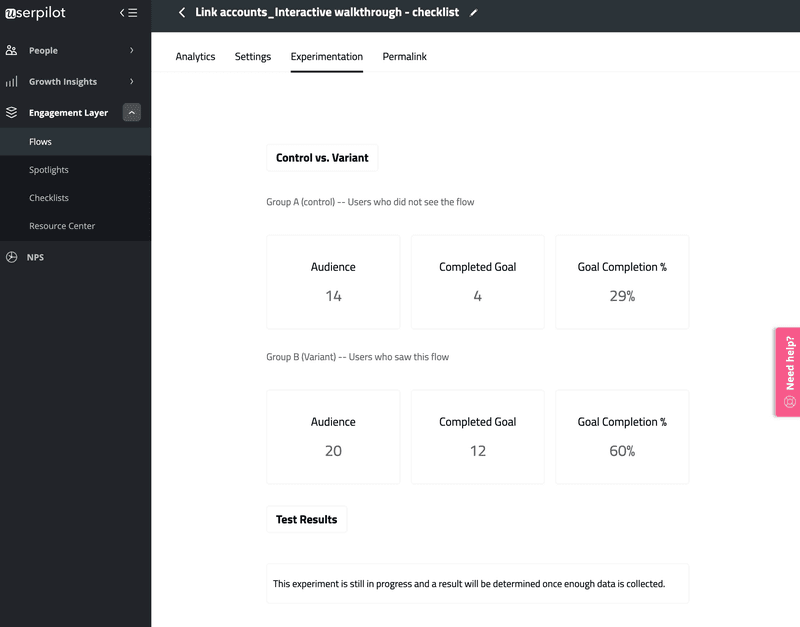
Userpilot enables you to A/B test your ideas without writing any code. You can also track experimentation results from your dashboard.
Growth engineering examples
Massive growth doesn’t happen by chance. Let’s now consider how two successful SaaS companies implemented growth engineering and what early-stage startups can learn from them.
Jira’s growth engineering experiment
Jira’s growth team discovered that a sizable amount of users combined Jira with Confluence Cloud, presenting an opportunity for improvement. Enter Pages, a feature that allows customers to link a Confluence Cloud Space to their Jira Project.
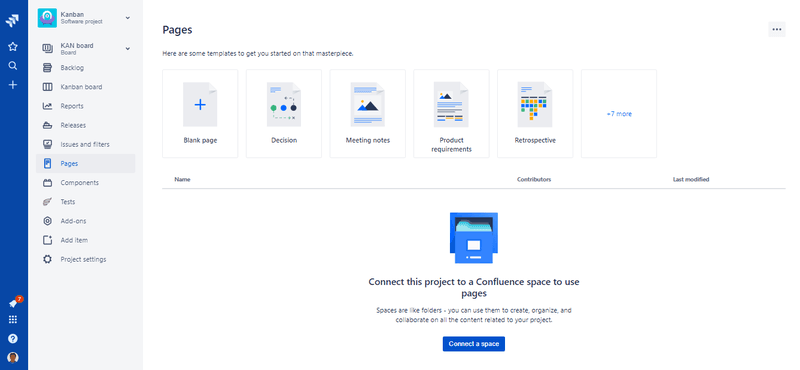
First, the product engineering teams from both Confluence and Jira collaborated to release an experimental feature of Pages under an A/B experiment to determine customer interest in the feature. With interest established, both teams continued to collaborate on the project to ensure smooth integration.
The final version was then released to 50 percent of customers, with the other 50 percent acting as the control group. After declaring the experiment a success, the team finally released Pages to all customers.
Netflix’s growth engineering experiment
According to Netflix, growth engineering guides the “business logic and protocols” that enable its UI partners to build lightweight and flexible applications for any platform. Thanks to its successful marketing and PR efforts, Netflix generates massive demand for its product daily, with growth engineers taking it from there.
Growth engineers track user demand to determine how they can optimize essential business metrics like conversion, retention, and revenue. The growth team builds, maintains, and operates the backend services for signup and login on platforms like desktops, tablets, mobile phones, and smart televisions.
They experiment with partners, payment methods, UI flows, and even signup flows to ensure a flawless experience. This extensive application of growth engineering within the Netflix microservice ecosystem is captured below:
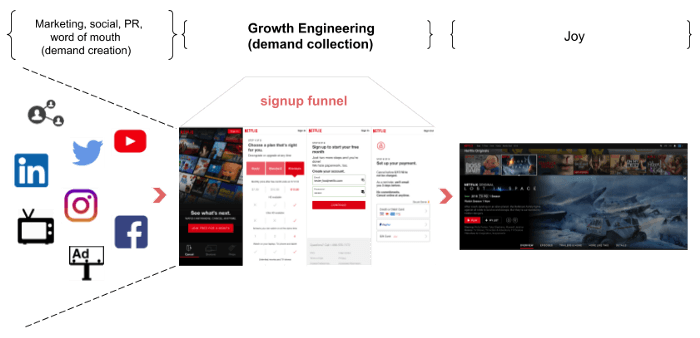
Conclusion
Growth engineering takes technical, marketing skills, and data analytics then combines them to improve conversion and retention. Powered by a growth mindset, growth teams take advantage of data to identify and experiment with growth opportunities.
Ready to take advantage of growth engineering to supercharge your growth? Userpilot helps you collect, track and analyze user data while experimenting with ideas. Book a demo to learn how!






